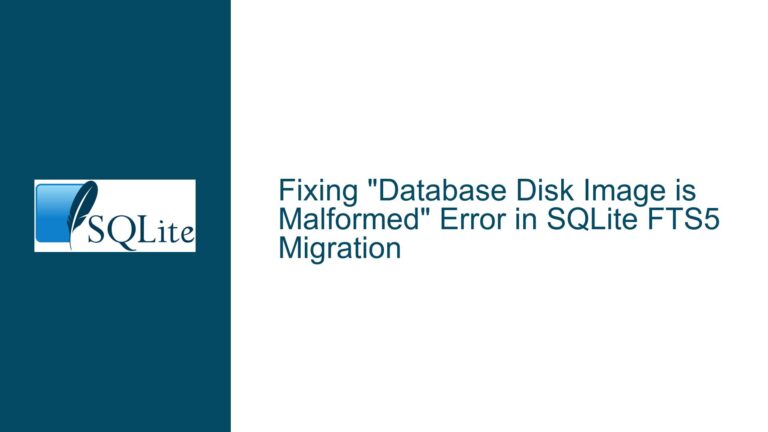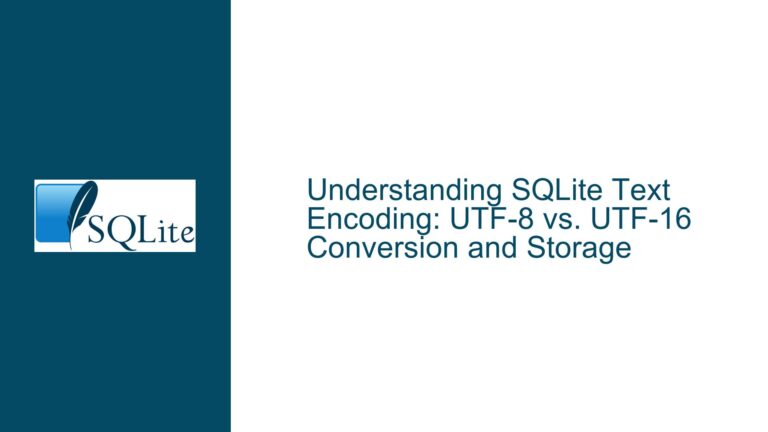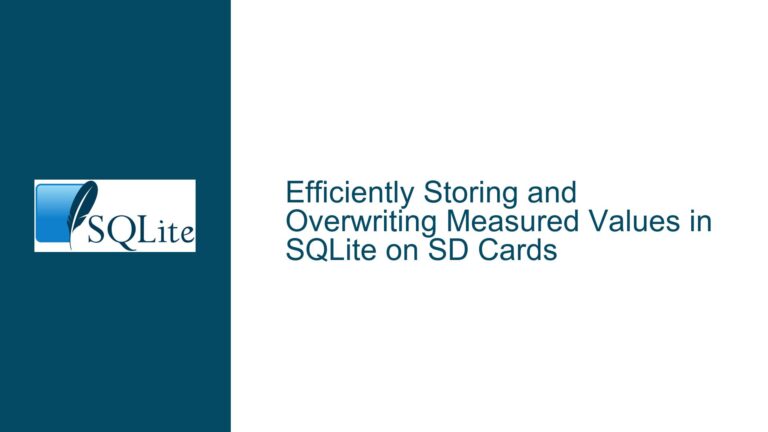SQLite CREATE TABLE AS SELECT Converts TIMESTAMP to NUM: Issue Analysis and Fixes
Issue Overview: TIMESTAMP to NUM Conversion in CREATE TABLE AS SELECT
When working with SQLite, a common operation is to create a new table based on the result of a query using the CREATE TABLE AS SELECT (CTAS) statement. However, a subtle yet significant issue arises when the source table contains columns explicitly declared as TIMESTAMP. During the CTAS operation, SQLite converts these TIMESTAMP columns into NUM (numeric) types. This behavior can lead to downstream issues, particularly when interfacing with tools like pandas, which expect consistent data types.
The problem manifests when a table, such as pods, has columns like started_at, created_at, ended_at, and scheduled_at explicitly defined as TIMESTAMP. After executing CREATE TABLE bar AS SELECT * FROM pods, the new table bar no longer retains the TIMESTAMP type for these columns. Instead, they are converted to NUM. This conversion can cause type mismatches when the data is exported to other systems or libraries, such as pandas, which may expect datetime strings but receive numeric values instead.
The root of this issue lies in SQLite’s type affinity system, which is designed to be flexible and forgiving. SQLite does not enforce strict data types like other relational databases. Instead, it uses a concept called "type affinity," where the declared type of a column is more of a suggestion than a strict rule. When creating a new table via CTAS, SQLite does not preserve the original column type declarations. Instead, it infers the type affinity based on the data and the query result, leading to the observed conversion of TIMESTAMP to NUM.
This behavior is particularly problematic in ETL (Extract, Transform, Load) pipelines, where data consistency and type preservation are critical. For example, if the pods table is part of a pipeline that exports data to a pandas DataFrame, the conversion of TIMESTAMP to NUM can cause errors when pandas attempts to parse the numeric values as datetime strings. This mismatch can disrupt the entire pipeline, requiring manual intervention to correct the data types.
Possible Causes: SQLite’s Type Affinity and CTAS Behavior
The conversion of TIMESTAMP to NUM in SQLite during a CTAS operation can be attributed to two primary factors: SQLite’s type affinity system and the behavior of the CREATE TABLE AS SELECT statement.
SQLite’s Type Affinity System
SQLite uses a dynamic type system, where the type of a value is associated with the value itself, not the column in which it is stored. This is in contrast to most other relational databases, where the column’s data type strictly defines what kind of data can be stored in it. In SQLite, columns have a "type affinity," which is a recommended type for the data stored in that column. The five type affinities in SQLite are TEXT, NUMERIC, INTEGER, REAL, and BLOB.
When a column is declared with a type like TIMESTAMP, SQLite does not recognize TIMESTAMP as a distinct type. Instead, it maps TIMESTAMP to the NUMERIC affinity. This mapping is based on SQLite’s rules for determining type affinity, which are designed to be flexible and accommodating. As a result, when you declare a column as TIMESTAMP, SQLite treats it as NUMERIC under the hood.
CREATE TABLE AS SELECT Behavior
The CREATE TABLE AS SELECT statement in SQLite creates a new table based on the result set of a query. However, it does not preserve the original column type declarations from the source table. Instead, it infers the column types based on the data and the query result. This inference process is influenced by SQLite’s type affinity system.
When you execute CREATE TABLE bar AS SELECT * FROM pods, SQLite creates the new table bar with columns that have the same names as those in pods. However, the type affinity of each column in bar is determined by the data returned by the query. Since SQLite treats TIMESTAMP as NUMERIC, the columns that were originally TIMESTAMP in pods are created as NUM in bar.
This behavior is documented in SQLite’s official documentation, which states that the CREATE TABLE AS SELECT statement does not copy the exact column definitions from the source table. Instead, it creates a new table with columns that have the same names but may have different type affinities.
Implications for Data Pipelines
The conversion of TIMESTAMP to NUM during a CTAS operation can have significant implications for data pipelines, especially those that involve exporting data to other systems or libraries. For example, if the pods table is part of an ETL pipeline that exports data to a pandas DataFrame, the conversion of TIMESTAMP to NUM can cause errors when pandas attempts to parse the numeric values as datetime strings.
This issue is particularly problematic because it occurs silently, without any warning or error from SQLite. The data pipeline may continue to run without any apparent issues until it reaches the point where the data is exported to another system. At that point, the type mismatch can cause the pipeline to fail, requiring manual intervention to correct the data types.
Troubleshooting Steps, Solutions & Fixes: Preserving TIMESTAMP in CTAS Operations
To address the issue of TIMESTAMP columns being converted to NUM during a CREATE TABLE AS SELECT operation, several approaches can be taken. These solutions range from modifying the schema design to using alternative SQLite features that preserve column types.
Solution 1: Explicitly Define Column Types in the New Table
One way to preserve the TIMESTAMP type in the new table is to explicitly define the column types when creating the table. Instead of using CREATE TABLE AS SELECT, you can use a combination of CREATE TABLE and INSERT INTO SELECT statements. This approach allows you to specify the exact column types for the new table, ensuring that the TIMESTAMP columns are preserved.
For example, instead of:
CREATE TABLE bar AS SELECT * FROM pods;
You can use:
CREATE TABLE bar (
uid TEXT,
name VARCHAR(256),
namespace VARCHAR(256),
resources TEXT,
labels TEXT,
started_at TIMESTAMP,
created_at TIMESTAMP,
ended_at TIMESTAMP,
scheduled_at TIMESTAMP,
task_queue VARCHAR(50)
);
INSERT INTO bar SELECT * FROM pods;
This approach ensures that the TIMESTAMP columns in the new table bar are explicitly defined, preventing SQLite from converting them to NUM.
Solution 2: Use SQLite’s WITHOUT ROWID Option
Another approach is to use SQLite’s WITHOUT ROWID option when creating the new table. This option changes the way SQLite stores the table, which can sometimes affect how column types are handled. However, this approach is more of a workaround and may not always preserve the TIMESTAMP type.
For example:
CREATE TABLE bar WITHOUT ROWID AS SELECT * FROM pods;
While this approach may work in some cases, it is not a guaranteed solution and should be tested thoroughly before being used in production.
Solution 3: Modify the ETL Pipeline to Handle Type Conversion
If modifying the schema or the SQL statements is not feasible, another approach is to modify the ETL pipeline to handle the type conversion. This can be done by explicitly converting the NUM columns back to TIMESTAMP before exporting the data to pandas or another system.
For example, in Python, you can use the pandas.to_datetime() function to convert the numeric values back to datetime objects:
import pandas as pd
# Assuming df is the DataFrame created from the SQLite query
df['started_at'] = pd.to_datetime(df['started_at'], unit='s')
df['created_at'] = pd.to_datetime(df['created_at'], unit='s')
df['ended_at'] = pd.to_datetime(df['ended_at'], unit='s')
df['scheduled_at'] = pd.to_datetime(df['scheduled_at'], unit='s')
This approach ensures that the datetime columns are correctly interpreted by pandas, even if they were converted to numeric values by SQLite.
Solution 4: Use SQLite’s CAST Function in the Query
Another approach is to use SQLite’s CAST function in the query to explicitly cast the TIMESTAMP columns to the desired type. This can be done within the SELECT statement used in the CREATE TABLE AS SELECT operation.
For example:
CREATE TABLE bar AS
SELECT
uid,
name,
namespace,
resources,
labels,
CAST(started_at AS TIMESTAMP) AS started_at,
CAST(created_at AS TIMESTAMP) AS created_at,
CAST(ended_at AS TIMESTAMP) AS ended_at,
CAST(scheduled_at AS TIMESTAMP) AS scheduled_at,
task_queue
FROM pods;
This approach ensures that the TIMESTAMP columns are explicitly cast to the correct type, preventing SQLite from converting them to NUM.
Solution 5: Use SQLite’s ATTACH DATABASE Feature
If preserving the exact schema and column types is critical, another approach is to use SQLite’s ATTACH DATABASE feature to create a new table in a separate database with the same schema as the source table. This approach allows you to copy the schema and data while preserving the column types.
For example:
ATTACH DATABASE 'source.db' AS source;
CREATE TABLE bar AS SELECT * FROM source.pods;
DETACH DATABASE source;
This approach ensures that the new table bar has the same schema as the source table pods, including the TIMESTAMP columns.
Solution 6: Use SQLite’s PRAGMA table_info to Dynamically Generate Schema
If you need to dynamically generate the schema for the new table based on the source table, you can use SQLite’s PRAGMA table_info statement to retrieve the column definitions and then generate the CREATE TABLE statement accordingly.
For example:
-- Retrieve the column definitions from the source table
PRAGMA table_info(pods);
-- Use the retrieved column definitions to generate the CREATE TABLE statement
CREATE TABLE bar (
uid TEXT,
name VARCHAR(256),
namespace VARCHAR(256),
resources TEXT,
labels TEXT,
started_at TIMESTAMP,
created_at TIMESTAMP,
ended_at TIMESTAMP,
scheduled_at TIMESTAMP,
task_queue VARCHAR(50)
);
-- Insert the data from the source table into the new table
INSERT INTO bar SELECT * FROM pods;
This approach ensures that the new table bar has the same schema as the source table pods, including the TIMESTAMP columns.
Solution 7: Use SQLite’s VACUUM INTO Command
SQLite’s VACUUM INTO command can be used to create a new database file with the same schema and data as the source database. This approach ensures that the new database file has the same schema as the source database, including the TIMESTAMP columns.
For example:
VACUUM INTO 'new_database.db';
This approach creates a new database file new_database.db with the same schema and data as the source database, including the TIMESTAMP columns.
Solution 8: Use SQLite’s EXPLAIN and EXPLAIN QUERY PLAN to Debug
If you are unsure why the TIMESTAMP columns are being converted to NUM, you can use SQLite’s EXPLAIN and EXPLAIN QUERY PLAN statements to debug the issue. These statements provide detailed information about how SQLite is executing the query, which can help you identify any issues with type conversion.
For example:
EXPLAIN QUERY PLAN CREATE TABLE bar AS SELECT * FROM pods;
This approach provides detailed information about how SQLite is executing the CREATE TABLE AS SELECT statement, which can help you identify any issues with type conversion.
Solution 9: Use SQLite’s sqlite3 Module in Python to Handle Type Conversion
If you are using Python to interact with SQLite, you can use the sqlite3 module to handle type conversion manually. This approach allows you to explicitly convert the NUM columns back to TIMESTAMP before exporting the data to pandas or another system.
For example:
import sqlite3
import pandas as pd
# Connect to the SQLite database
conn = sqlite3.connect('example.db')
cursor = conn.cursor()
# Execute the query and fetch the data
cursor.execute("SELECT * FROM pods")
rows = cursor.fetchall()
# Convert the numeric columns back to datetime
data = []
for row in rows:
converted_row = list(row)
converted_row[5] = pd.to_datetime(converted_row[5], unit='s') # started_at
converted_row[6] = pd.to_datetime(converted_row[6], unit='s') # created_at
converted_row[7] = pd.to_datetime(converted_row[7], unit='s') # ended_at
converted_row[8] = pd.to_datetime(converted_row[8], unit='s') # scheduled_at
data.append(converted_row)
# Create a DataFrame from the converted data
df = pd.DataFrame(data, columns=[description[0] for description in cursor.description])
# Close the connection
conn.close()
This approach ensures that the datetime columns are correctly interpreted by pandas, even if they were converted to numeric values by SQLite.
Solution 10: Use SQLite’s sqlite_master Table to Retrieve Schema Information
If you need to dynamically retrieve the schema information from the source table, you can use SQLite’s sqlite_master table to retrieve the CREATE TABLE statement for the source table. This approach allows you to generate the CREATE TABLE statement for the new table based on the schema of the source table.
For example:
-- Retrieve the CREATE TABLE statement for the source table
SELECT sql FROM sqlite_master WHERE type = 'table' AND name = 'pods';
-- Use the retrieved CREATE TABLE statement to create the new table
CREATE TABLE bar (
uid TEXT,
name VARCHAR(256),
namespace VARCHAR(256),
resources TEXT,
labels TEXT,
started_at TIMESTAMP,
created_at TIMESTAMP,
ended_at TIMESTAMP,
scheduled_at TIMESTAMP,
task_queue VARCHAR(50)
);
-- Insert the data from the source table into the new table
INSERT INTO bar SELECT * FROM pods;
This approach ensures that the new table bar has the same schema as the source table pods, including the TIMESTAMP columns.
Conclusion
The conversion of TIMESTAMP to NUM during a CREATE TABLE AS SELECT operation in SQLite is a subtle but significant issue that can disrupt data pipelines and cause type mismatches when exporting data to other systems or libraries. This behavior is rooted in SQLite’s type affinity system and the way the CREATE TABLE AS SELECT statement handles column types.
To address this issue, several solutions can be employed, ranging from explicitly defining column types in the new table to modifying the ETL pipeline to handle type conversion. Each solution has its own advantages and trade-offs, and the best approach depends on the specific requirements of your data pipeline.
By understanding the underlying causes of this issue and applying the appropriate solutions, you can ensure that your SQLite databases maintain data consistency and type integrity, even when performing complex operations like CREATE TABLE AS SELECT.






